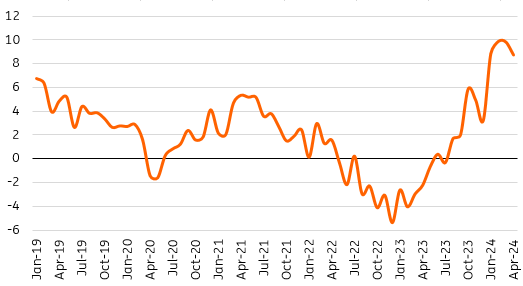Polish wage growth continued at a double-digit pace in April. Meanwhile, the average paid employment contracted 0.4% YoY in April as demand for labor showed a delayed reaction to the slow economic growth seen in 2023. Still, supply-side constraints are prevailing in the labor market.

depositphotos
Averages wages and salaries in the enterprise sector rose 11.3% year-on-year in April, i.e., slightly slower than consensus (12.1%), after growing by 12.0% YoY in the previous month. In real terms, annual wage growth has stayed close the top since the late 1990s and early 2000s. Wage pressures are fueled by very low unemployment (with labor Force Survey unemployment at its lowest level in the EU, equal to the Czech Republic), as well as regulatory changes such as a very high minimum wage hike.
Real wages growth remains elevated
Real wage and salary in enterprise sector, %YoY

GUS, ING.
At the same time, some divisions of manufacturing are showing signs of softer demand for labor. Its negative impact on wages is still overshadowed by the minimum wage hike. Revenues from social benefits and wages in the public sector are rising rapidly. As a result, domestic demand remains strong enough that a large deterioration in the condition of the labor market has not occurred. Therefore, wage growth remains elevated.
A decline in the average paid employment deepened to 0.4% YoY (consensus: -0.3%), after -0.2% YoY in March. Although with a considerable lag, employment levels are gradually responding to the weaker economy we've seen in 2023 – but the magnitude of the deterioration is negligible. For the time being, the most pronounced job declines are being recorded by some export industries and are offset by rising employment in other domestic companies or created by FDIs.
Limited labor supply is the main barrier to employment growth rather than low demand for workers. The number of vacancies per unemployed person has not deteriorated, showing resilient demand for labor. Companies are reluctant to cut jobs, fearing that they will not be able to find employees when economic growth accelerates further.
More By This Author:
April’s Rebound In Polish Production Offsets Dismal March Reading Stubborn UK Services Inflation Reduces Chance Of June Rate Cut FX Daily: Divergence, Divergence, Divergence
Disclaimer: This publication has been prepared by the Economic and Financial Analysis Division of ING Bank N.V. (“ING”) solely for information purposes without regard to any ...
more
Disclaimer: This publication has been prepared by the Economic and Financial Analysis Division of ING Bank N.V. (“ING”) solely for information purposes without regard to any particular user's investment objectives, financial situation, or means. ING forms part of ING Group (being for this purpose ING Group NV and its subsidiary and affiliated companies). The information in the publication is not an investment recommendation and it is not investment, legal or tax advice or an offer or solicitation to purchase or sell any financial instrument. Reasonable care has been taken to ensure that this publication is not untrue or misleading when published, but ING does not represent that it is accurate or complete. ING does not accept any liability for any direct, indirect or consequential loss arising from any use of this publication. Unless otherwise stated, any views, forecasts, or estimates are solely those of the author(s), as of the date of the publication and are subject to change without notice.
The distribution of this publication may be restricted by law or regulation in different jurisdictions and persons into whose possession this publication comes should inform themselves about, and observe, such restrictions.
Copyright and database rights protection exists in this report and it may not be reproduced, distributed or published by any person for any purpose without the prior express consent of ING. All rights are reserved. ING Bank N.V. is authorised by the Dutch Central Bank and supervised by the European Central Bank (ECB), the Dutch Central Bank (DNB) and the Dutch Authority for the Financial Markets (AFM). ING Bank N.V. is incorporated in the Netherlands (Trade Register no. 33031431 Amsterdam). In the United Kingdom this information is approved and/or communicated by ING Bank N.V., London Branch. ING Bank N.V., London Branch is deemed authorised by the Prudential Regulation Authority and is subject to regulation by the Financial Conduct Authority and limited regulation by the Prudential Regulation Authority. The nature and extent of consumer protections may differ from those for firms based in the UK. Details of the Temporary Permissions Regime, which allows EEA-based firms to operate in the UK for a limited period while seeking full authorisation, are available on the Financial Conduct Authority’s website.. ING Bank N.V., London branch is registered in England (Registration number BR000341) at 8-10 Moorgate, London EC2 6DA. For US Investors: Any person wishing to discuss this report or effect transactions in any security discussed herein should contact ING Financial Markets LLC, which is a member of the NYSE, FINRA and SIPC and part of ING, and which has accepted responsibility for the distribution of this report in the United States under applicable requirements.
less
How did you like this article? Let us know so we can better customize your reading experience.





